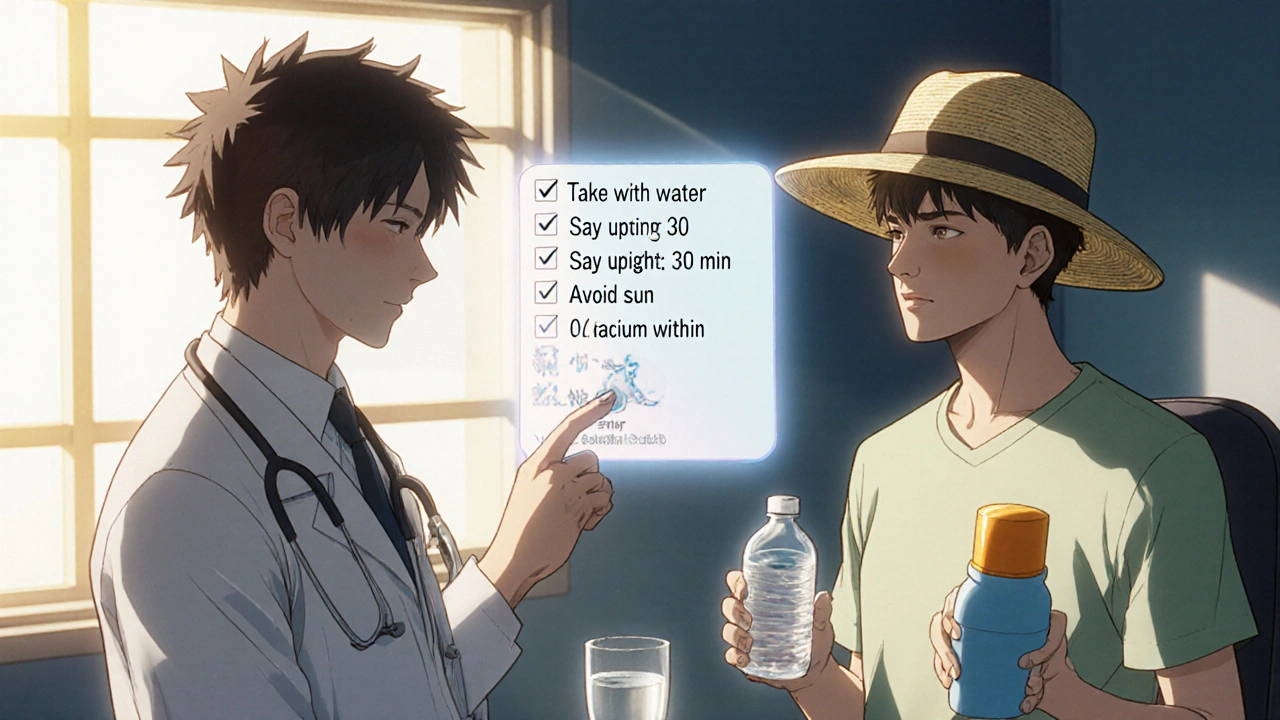Antibiotic Decision Tool
Which Antibiotic Is Right for You?
Answer a few questions about your condition and preferences to get a personalized recommendation.
Why this recommendation?
Doxt‑SL (Doxycycline) is a branded slow‑release tablet of doxycycline hyclate designed for infections like acne, respiratory tract infections, and Lyme disease. It carries the generic name doxycycline and is marketed in the UK by several online pharmacies. Compared with other antibiotics, Doxt‑SL promises steadier blood levels and a reduced dosing frequency, but how does it really stack up?
Why Compare Doxt‑SL with Other Options?
When a clinician or a patient picks an oral antibiotic, the decision isn’t just about “it works”. Cost, side‑effect profile, dosing convenience, and resistance risk all play a part. By laying out the key attributes of Doxt‑SL side‑by‑side with common alternatives, you can see where it shines and where another drug might make more sense.
Quick Reference Cheat Sheet
- Doxt‑SL (Doxycycline): Slow‑release, twice‑daily for most infections, moderate cost, good for acne and atypical pneumonia.
- Minocycline: Similar tetracycline class, once‑daily dosing, higher cost, stronger effect on acne but higher risk of vestibular side effects.
- Azithromycin: Macrolide, once‑daily, short course (3‑5 days), higher price, excellent for chlamydia and some respiratory infections.
- Amoxicillin: Penicillin class, three‑times‑daily, cheap, best for streptococcal throat and ear infections.
Core Comparison Table
| Attribute | Doxt‑SL (Doxycycline) | Minocycline | Azithromycin | Amoxicillin |
|---|---|---|---|---|
| Class | Tetracycline | Tetracycline | Macrolide | Penicillin |
| Typical Dose | 100 mg twice daily (SR) or 200 mg once daily | 100 mg once daily | 500 mg on day 1, then 250 mg daily for 4 days | 500 mg three times daily |
| Half‑life | ≈18 hours | ≈16 hours | ≈68 hours (tissue) | ≈1 hour |
| Spectrum | Broad - Gram‑positive, Gram‑negative, atypical, some protozoa | Broad, slightly better on resistant acne strains | Mostly atypical and some Gram‑positive | Primarily Gram‑positive, some Gram‑negative |
| Common Side Effects | Gastro‑intestinal upset, photosensitivity, esophagitis | Vertigo, skin hyperpigmentation, photosensitivity | Diarrhoea, QT prolongation, liver enzyme rise | Rash, diarrhoea, rare anaphylaxis |
| Cost (UK, 2025) | £7‑9 for 28 tablets | £12‑15 for 28 tablets | £20‑25 for a 5‑day pack | £3‑4 for 21 capsules |
| Resistance Concerns | Increasing tetracycline resistance in some regions | Similar resistance pattern to doxycycline | Macrolide resistance rising in streptococci | Beta‑lactamase producing organisms increasingly resistant |

Deep Dive: Doxt‑SL (Doxycycline) Details
Doxt‑SL uses a patented matrix that releases doxycycline over 12‑14 hours, allowing a twice‑daily schedule for most infections. The drug is absorbed well even on an empty stomach, though taking it with a full glass of water and staying upright for 30 minutes reduces esophageal irritation.
According to the British National Formulary (BNF), the standard adult dose for uncomplicated skin infections is 100 mg twice daily for 7‑14 days. For travelling‑related malaria prophylaxis, a lower 100 mg once daily dose is recommended after the initial loading phase.
One of the biggest selling points is the drug’s ability to cross the blood‑brain barrier, making it useful for neuro‑borreliosis (Lyme disease affecting the nervous system). However, patients should be warned about two known quirks: photosensitivity (sunburn‑like reactions on minimal exposure) and potential interaction with calcium‑rich foods or antacids, which can chelate the molecule and cut absorption by up to 40 %.
Alternative 1: Minocycline
Minocycline is another tetracycline‑class antibiotic that also enjoys good skin‑penetration. The drug’s main advantage is once‑daily dosing, which some patients find easier to stick to.
Typical acne regimens use 100 mg once daily for 3‑6 months. Though it’s effective against resistant acne strains, minocycline carries a higher risk of vestibular side effects-dizziness, tinnitus, and a feeling of the room spinning-especially in people over 60.
Cost‑wise, minocycline tends to be pricier than generic doxycycline but still cheaper than many newer agents. In the UK market, a 28‑tablet pack ranges from £12‑15.
Alternative 2: Azithromycin
Azithromycin belongs to the macrolide family and is famed for its short, once‑daily regimen. A typical 5‑day course (1 g on day 1, then 500 mg daily) simplifies adherence, which is why it’s popular for sexually transmitted infections and atypical pneumonia.
Its long tissue half‑life (≈68 hours) allows the drug to stay active even after plasma levels fall, but this also means it can linger in the body and interact with other medications that affect heart rhythm. QT‑prolongation warnings are now standard on the NHS prescribing guidelines.
Price is a drawback; a full course costs roughly £20‑25, which can be a barrier for patients without private insurance.

Alternative 3: Amoxicillin
Amoxicillin is the workhorse of the penicillin group. It’s cheap, widely available, and has a well‑known safety profile. The drug is usually given three times daily, which can be inconvenient for some patients.
It’s first‑line for streptococcal pharyngitis, otitis media, and many community‑acquired urinary tract infections. However, it lacks activity against atypical organisms like Mycoplasma or Chlamydia, where a tetracycline or macrolide is preferred.
Resistance trends are moving upward, especially in regions where beta‑lactamase‑producing bacteria are common. The NHS now recommends checking local resistance data before defaulting to amoxicillin for sinus infections.
Choosing the Right Antibiotic: Decision Framework
Here’s a quick mental checklist you can run through when deciding between Doxt‑SL and the alternatives:
- Infection type: Is it skin‑related, respiratory, or something atypical?
- Resistance patterns: Does your local antibiogram show high tetracycline resistance?
- Patient factors: Can the patient tolerate photosensitivity? Are they on meds that prolong QT?
- Dosing convenience: Do you need once‑daily dosing for better adherence?
- Cost constraints: What does the patient’s insurance or NHS prescription budget allow?
For many adult acne patients without heart‑risk factors, Doxt‑SL offers a solid balance of efficacy, cost, and manageable side‑effects. For travelers needing a short, simple regimen for chlamydia, azithromycin may be the better pick. If a patient complains of severe photosensitivity, minocycline or amoxicillin could be safer alternatives.
Practical Tips for Using Doxt‑SL Safely
- Take with a full glass of water; stay upright for 30 minutes.
- Avoid excessive sun exposure; wear UV‑protective clothing and sunscreen (SPF 30+).
- Do not combine with calcium‑rich dairy or antacids within 2 hours of dosing.
- Complete the full course even if symptoms improve after a few days.
- Notify your doctor if you develop severe abdominal pain, persistent vomiting, or a rash.

Frequently Asked Questions
Frequently Asked Questions
What makes Doxt‑SL different from regular doxycycline tablets?
Doxt‑SL uses a slow‑release matrix that spreads the drug’s absorption over 12‑14 hours, allowing twice‑daily dosing for most infections. Regular doxycycline tablets release the drug quickly, often requiring three doses a day.
Is Doxt‑SL safe for pregnant women?
Doxycycline is generally contraindicated in pregnancy, especially after the first trimester, due to potential effects on fetal bone growth and tooth discoloration. Pregnant patients should discuss safer alternatives with their clinician.
Can I take Doxt‑SL with a proton‑pump inhibitor?
PPI drugs can lower the absorption of doxycycline by up to 40 %. It’s best to separate the doses by at least two hours or switch to a non‑acid‑suppressing regimen if possible.
Which antibiotic is best for acne‑prone skin?
Both Doxt‑SL (doxycycline) and minocycline are effective for inflammatory acne. Doxycycline is usually first‑line because it’s cheaper and has a slightly lower risk of vestibular side effects. Minocycline may be chosen if a patient cannot tolerate doxycycline’s photosensitivity.
How does antibiotic resistance affect the choice of Doxt‑SL?
If local resistance data show a high prevalence of doxycycline‑resistant strains, clinicians may opt for a different class, such as a macrolide or a beta‑lactam, depending on the infection. The NHS publishes regional resistance maps that can guide this decision.
Bottom Line
Doxt‑SL (doxycycline) sits comfortably in the middle of the antibiotic market: it’s affordable, works for a wide range of infections, and offers a convenient dosing schedule thanks to its slow‑release formulation. When you line it up against minocycline, azithromycin, and amoxicillin, its strengths shine in acne, Lyme disease, and respiratory infections where a broad‑spectrum agent is needed. The trade‑offs are photosensitivity, the need to avoid calcium‑rich meals, and emerging tetracycline resistance in some areas.
Use the decision framework above, check local resistance data, and factor in patient preferences to pick the right drug. When in doubt, a short consultation with your GP or NHS pharmacist can clarify which option aligns best with your health profile and budget.



Poornima Ganesan
October 18 2025Doxt‑SL's slow‑release matrix is fundamentally a pharmacokinetic marvel that stretches doxycycline absorption over a twelve‑ to fourteen‑hour window. This means plasma concentrations stay within the therapeutic window with only twice‑daily dosing, unlike conventional doxycycline that often peaks and dips dramatically. The steadier curve translates into fewer gastrointestinal upsets for many patients, because the gut isn’t hit with a sudden drug surge. Moreover, the formulation’s ability to cross the blood‑brain barrier makes it uniquely suited for neuro‑borreliosis, a niche where many alternatives fall short. When you stack Doxt‑SL against minocycline, the latter’s once‑daily convenience is offset by a higher incidence of vestibular toxicity, a trade‑off that many young adults cannot tolerate. Azithromycin’s short course is attractive on paper, yet its long tissue half‑life breeds QT‑prolongation concerns, especially in the elderly with polypharmacy. Amoxicillin remains cheap, but its narrow spectrum excludes atypical organisms, forcing physicians to add a second drug in mixed infections. Cost‑wise Doxt‑SL sits comfortably at £7‑9 for a month’s supply, which is a fraction of the £20‑25 price tag of a five‑day azithromycin pack. The UK resistance data from 2024 show a modest uptick in tetracycline‑resistant strains, but the rise is nowhere near the macrolide resistance spiralling in southern Europe. For acne, Doxt‑SL’s anti‑inflammatory properties are well documented, and the photosensitivity risk can be mitigated with sunscreen and limited sun exposure. Patients who ignore the calcium‑chelation warning and take the drug with dairy often report a 40 % drop in serum levels, effectively turning a potent antibiotic into a placebo. In clinical practice, adherence improves when the dosing schedule aligns with meals, and the twice‑daily regimen of Doxt‑SL is easy to pair with breakfast and dinner. From a pharmacist’s perspective, the drug’s safety profile is clean apart from the usual GI irritation, which is usually transient. If you factor in the indirect costs of treatment failure due to resistance, Doxt‑SL often saves the healthcare system money in the long run. Bottom line: for a broad‑spectrum indication that demands brain penetration, Doxt‑SL outperforms minocycline, azithromycin, and amoxicillin in a cost‑effective package. Just remember to advise patients about sun protection and to keep a full glass of water handy to avoid esophageal irritation.
Emma Williams
November 3 2025Doxy works, but price matters.
Stephanie Zaragoza
November 19 2025Doxycycline, including the Doxt‑SL formulation, possesses a broad antimicrobial spectrum; however, clinicians must weigh its pharmacodynamics against patient-specific factors, such as comorbidities and concomitant medications. The slow‑release technology prolongs therapeutic plasma levels, thereby reducing dosing frequency, which can enhance adherence-a critical determinant of treatment success. Nevertheless, photosensitivity remains a noteworthy adverse effect, necessitating rigorous patient counseling on ultraviolet exposure, sunscreen use, and protective clothing. In settings where local antibiograms indicate rising tetracycline resistance, alternative agents, such as azithromycin or amoxicillin, may be empirically preferred, provided the infection’s etiology aligns with their spectra.